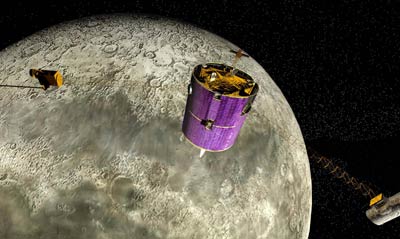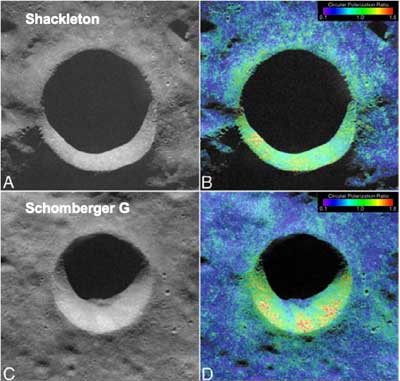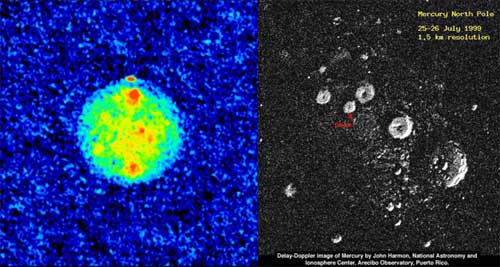Ice on the MoonEarth-based radar data. Radar has been used to study the Moon for decades with many observations made in preparation for the Apollo missions. This work largely concentrated on the equatorial regions (target sites for Apollo), but later work has focused on the lunar poles. Although some of their early work supported the concept, the most strident objections to the presence of lunar polar ice has come from planetary radar astronomers. Nick Stacy mapped the south pole of the Moon using the Arecibo telescope in 1992 for his Ph.D. dissertation. The Arecibo group found several zones of high CPR, although its distribution is patchy and discontinuous. They noted that some areas of high CPR occur within craters that might be permanently shadowed (at that time, lighting maps of the poles did not exist). Although couched in appropriately cautious terms, Stacy noted that one high CPR zone occurs within the crater Shackleton and that it appears to continue down into the portion of the crater floor in Earth shadow, out of view of the Arecibo dish. Attributing most of the high CPR to blocky, rough surfaces associated with craters, Stacy reserved the possibility that some high CPR spots could be ice if they occurred deep within permanently dark crater floors.
Subsequent work by the Arecibo group has moved away from this cautiously positive interpretation to a definitive assertion that none of the high CPR zones seen around the pole are caused by the presence of ice. In at least four papers published between 1997 and 2006, they have presented increasingly more detailed image data, each showing the same relations: patchy, high CPR found in both sunlight areas and in permanent darkness. The latest paper from the Arecibo group, published in October 2006 to a barrage of publicity (including an overwrought press release in which one investigator called the “door on the debate” on lunar polar ice detected by radar “closed”) shows the south pole of the Moon in unprecedented surface resolution, about 20 meters per pixel. Yet again, we see the high CPR patch in Shackleton (Figure 4), but this time, it is accompanied by an image and analysis of another crater, Schomberger G, which is alleged to have the same distribution of high CPR within it. As Schomberger G is in sunlight (and has high CPR in portions of its interior), the authors conclude that the high CPR in Shackleton is similarly caused by surface roughness and not by the presence of ice within the permanently dark area of the crater.
As all parties agree that high CPR is found in the polar regions of the Moon, the debate is over what this relation means. The Arecibo group claims that the distribution patterns in Schomberger G and Shackleton are the same (Figure 4); hence, the high CPR patches represent rocky outcrops on and within these craters, not ice. However, high CPR can be caused by either roughness or ice; in itself, high CPR is not uniquely diagnostic of either (Figure 2). I contend that because of its non-unique nature, high CPR within Shackleton could be ice; as near as can be determined, the high CPR patch occurs within a zone of permanent darkness. Why even entertain this notion? After all, if ice is unstable on any part of the Moon that sees sunlight, doesn’t that mean that high CPR here indicates roughness, not ice? In fact, similar relations are seen on the planet Mercury (Figure 5). The polar features of Mercury were initially discovered by Dewey Muhleman and colleagues at Caltech using very low resolution, global disk images. Although these images show a prominent high CPR zone near the north pole of Mercury (Fig. 5), they also show high CPR zones in mid-latitudes and equatorial regions. The interpretation of the authors of this work was that two mechanisms produce high CPR on Mercury; near the equator, surface roughness must be the cause of high CPR, but at the poles, water ice in permanent shadow could not ruled out (like the Moon, Mercury’s pole is normal to the plane of its orbit around the sun). Thus, two scattering mechanisms were invoked. In principle, there is no reason why such a relation would not also occur on our Moon. In such a case, high CPR can be caused by both roughness and ice. If a spot is in sunlight, it must be surface roughness, but if it’s in the permanent darkness, ice cannot be ruled out.
It is claimed by the Arecibo group that the distribution of high CPR within the two craters Shackleton and Schomberger G are identical. As Schomberger G is in partial sunlight, high CPR seen within it cannot be caused by ice. As a planetary geologist, I see significant differences in the distribution of CPR in the two craters (Figure 4). In Schomberger G, high CPR is found as a quasi-continuous upper “layer,” with CPR values decreasing deeper into the crater. At Shackleton, the upper crater wall is complex and high CPR is discontinuous; the large zone of high CPR within the crater at about 8 o’clock (Figure 4) starts below the rim, but continues down into the crater, disappearing into the shadow caused by the Earth-Moon geometry. I leave it to readers to decide for themselves whether the distribution of high CPR is identical in these two craters. All of the interior of Shackleton is in permanent darkness, shielded from sunlight and has been continuously for at least the last two billion years. So in theory, ice may have accumulated within it. Thus, three data sets exist, each unique, on the possibility of lunar polar ice. But what are they telling us? Synthesis: Best guess on polar volatilesNo single piece of evidence for lunar ice is decisive, but I think the preponderance of evidence indicates that water ice exists in permanently dark areas near the poles. However, its origin and the processes associated with its deposition are unclear. The ice could be of cometary, meteoritic, or solar wind origin; each mode would have interesting implications for its composition. If largely of cometary origin, other volatile species of great utility may also be present, such as ammonia (NH3), methane (CH4), and various organic substances. Nitrogen is particularly useful in supporting human life, both for breathing air and for agriculture. Whatever the source, polar ice is a useful resource for future lunar inhabitants.
Much remains unclear about the nature of ice is on the Moon. Rates of deposition of polar ice and implications for its physical nature are unknown. We can, however, make some inferences from the data in hand. Ice deposits cover a minority of the polar terrain and concentrations of it could vary widely over a small area, leading to a very heterogeneous deposit. This supposition is suggested by the patchy distribution of high CPR spots in the Earth-based radar data (not all of which are caused by ice; see section above). The concentration and distribution of the ice is unknown, but if very heterogeneous as suggested, deposits could locally cover between 10–50 percent of a given patch of dark area. Individual bodies of trapped ice could be on the order of meters to tens of meters in size, as suggested by the patchy extent of high CPR areas seen in the polar darkness. From the fast neutron data of Lunar Prospector, the uppermost 10 centimeters or so of the polar dark regions are depleted in hydrogen. Radar data suggest volume scattering at depths on the order of several tens of wavelengths of the S-band radar (~13 centimeters). Thus, ice occurs between depths of 10 centimeters and 2–3 meters. From our current understanding of the creation, turnover, and evolution of the lunar soil, the ice is probably not “pure” but contains contaminants and solid inclusions of varying concentrations. Although water ice is expected to dominate the deposit, other minor species of cometary origin could be present in useful quantities. The terrain of a lunar highlands region (found at both lunar poles) can be very rugged, with local slopes exceeding 30 degrees. However, as shown by the Apollo 16 highland landing site, such areas can be negotiated reasonably well, if the correct paths are chosen. So what?Water ice on the Moon makes living there easier, cheaper, and thus, more likely. Solar wind hydrogen is found everywhere on the Moon, but in vanishingly small quantities. Ice at the poles is a concentrated source of both hydrogen and oxygen—two substances vital to supporting human life and creating a space transportation infrastructure. We can extract what we need out of the equatorial regolith, but it’s much harder and more energy intensive than at the poles. Extracting solar wind hydrogen requires heating soil to about 700° C, at which point 90 percent of the adsorbed gas is driven off. In contrast, icy regolith heated to about 100° C gives off water as an easily collected and stored gas. Per unit mass, it takes roughly two orders of magnitude less energy to extract hydrogen from icy polar regolith than it does by roasting soil at the equator. Although polar ice is important, it is not a requirement to successfully live and work on the Moon. The poles of Moon are primarily attractive due to the near-permanent sunlight found in several areas. Such lighting is significant from two perspectives. First, it provides a constant source of clean power and allows humans to live on the Moon without having to survive the two-week-long lunar night experienced on the equator and at mid-latitudes. Second, because these areas are illuminated by the Sun at grazing angles of incidence, the surface never gets very hot or very cold. Sunlit areas near the poles are a benign thermal environment, with an estimated temperature of about –50° ± 10°C. Having water near these locales would be a huge bonus. The most compelling reason to go to the poles is to solve the problem of surviving the extended lunar night—a task that, at most other places on the Moon, would probably require spending billions of dollars for a nuclear reactor.
Science is an imperfect process. At any given point in time, we have limited data of less than optimum quality and nearly always imperfectly or incompletely understood. Our information on lunar polar ice is limited in both quality and quantity. No question in modern science is “solved” and the presence of “consensus,” while a useful concept in marketing and politics, has no real value to the truth or falsity of scientific questions. The way the universe is put together and works is quite independent of the collective opinions of the experts. To answer the question of lunar polar ice, we need more and better data. We must first thoroughly map the polar deposits from lunar orbit. India is preparing to launch their first mission to the Moon, Chandrayaan-1, in early 2008. I am on a team that will build and fly the radar mapping instrument on that mission. This radar will map both poles using a revolutionary new processing architecture that allows us to distinguish areas of high CPR caused by roughness and those caused by the presence of ice. An even more advanced radar instrument will be on the US Lunar Reconnaissance Orbiter (LRO) mission in late 2008, mapping in two frequency bands (potentially distinguishing roughness from ice) and in high resolution, showing patches of ice as small as 20 meters across. Chandrayaan will systematically map the polar regions at moderate resolution (75 meters/pixel.) On the subsequent LRO mission, we will get high-resolution coverage (10 meters/pixel) at multiple wavelengths of promising targets seen in that data. Since these two missions overlap and will orbit the Moon at the same time, we can use both instruments on the two spacecraft to make bistatic images of the polar deposits; such a mode of operation can observe scattering through the phase angle (looking for the CBOE effect, a good discriminator between ice and roughness). Together, these missions will map the extent and distribution of anomalous material in the polar regions of the Moon. A key advantage of orbital mapping is the ability to look into all of the areas of permanent darkness. In a recent article in Scientific American (“Radar Images Fail to Detect Ice at Lunar Poles”, October 2006), Don Campbell of Cornell University, part of the Arecibo team, notes that the lunar orbiters LRO and Chandrayaan “will get a better view of the polar terrain than we can from Earth.” The LRO spacecraft will carry other instruments, including a thermal mapper to determine temperatures of the dark areas, a laser altimeter to measure the topography of the poles (needed to make definitive maps of sunlight and darkness) and other instruments designed to characterize the environment and deposits of the polar regions. In addition, other nations (including China and Japan) are flying lunar orbiters carrying a variety of mapping instruments. The Moon, once the most poorly mapped body in the Solar System, appears ready to become the most thoroughly charted and remotely studied object in the history of mankind. The next step is critical. After polar deposits have been mapped from orbit, we must land at a promising target and measure volatile substances in the soil. As described above, no matter what high-quality remote sensing data we obtain, there is always ambiguity in interpreting remote sensing data. We must have ground truth. Going into the polar darkness, digging up the soil, and measuring what’s there will finally answer, in a definitive manner, the nagging question we started with: Is there ice on the Moon?
After the first lander, we should survey potential mining prospects, map the distribution of ice on small, local scales (hundreds of meters), and experiment with different extraction methods, water separation technologies, and resource processing and storage techniques. The goals of lunar resource utilization are challenging, but significant experience can be gathered from small robotic landers prior to the arrival of people. A program of robotic missions can provide critical strategic information as well as gaining operational experience and providing milestones for a human lunar return. The Moon is not a hostile, barren rock in space—it is humanity’s stepping-stone into the Solar System. The poles of the Moon are inviting “oases” for humans in the desert of near-Earth space. To live there and at destinations beyond, we must identify resources that will support human life and enable the creation of a new spacefaring infrastructure. Home |
|


